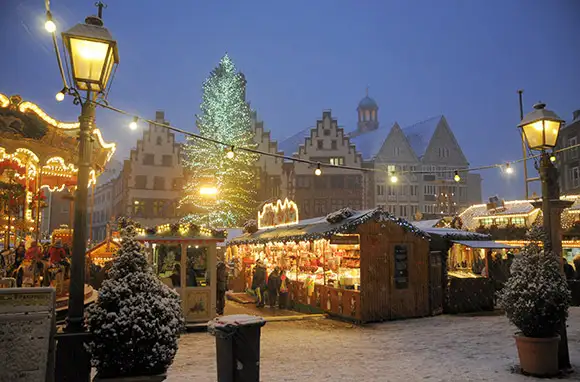
This is my first winter living in Germany, and nearly everywhere I’ve visited since late-November has brought me to a Christmas market, often called Weihnachtsmarkt or Christkindlmarkt. They’re characterized by a few telltale signs: clusters of small wooden huts and aromas of roasting chestnuts, grilled sausages, and spiced wine (or gluhwein).
Germany’s markets, which date back to the Middle Ages, vary according to many factors: geography, location, time of day, and day of week. But they share a few commonalities, too: handmade toys, nutcrackers and smokers, local delicacies, and groups of friends and strangers huddled around tables with steaming mugs wrapped in their hands. As with any festival in Germany, you’ll pay a pfand (deposit) for the cup, stemware, or mug your drink comes in. You can get your money by returning the empty cup (or keep it as a cheap souvenir).
Most markets begin the weekend before the first Sunday of Advent. But places like Oberwesel—a small town on the Rhine—hold a market solely on the first weekend of Advent. And don’t make the same rookie mistake I did: The fifth Sunday before Christmas is Totensonntag, a German holiday. Even though Sundays in Germany are notoriously quiet—nearly everything is shut down—Christmas markets are usually the exception to this rule. I learned the hard way that some markets, like the one in Koblenz, shut down on Totensonntag.
With thousands of villages and cities to choose from for this story, I decided to visit markets in areas that I wanted to explore for other reasons, too. While some are sizeable enough that you could spend an entire day browsing (and re-browsing) booths, usually a few hours of exploration will suffice. I also confirmed the obvious advice to go during the week and visit early (but not too early; especially on Sundays, many booths get a slow start). Of course, when you avoid crowds, you also miss out on a certain holiday cheer that only comes from (unintentionally) bouncing off of your neighbors’ puffy jackets.
Of the literally dozens of markets I scoped out (and drank the gluhwein to prove it—all for you, faithful readers), these are the ones that stood out.
Like this story? Join the 1 million other travelers who read our free newsletter. It’s full of our best tips, trip ideas, and travel deals. Subscribe here today!
Image Gallery
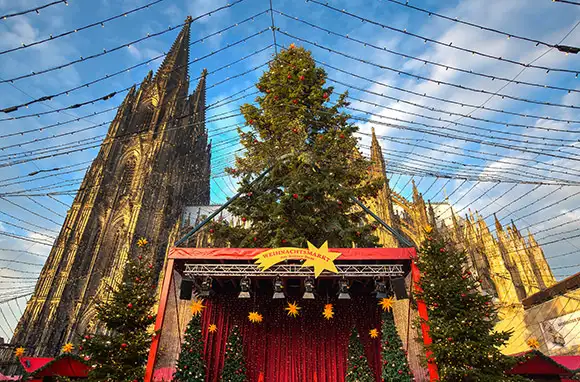
Koln
Koln, or Cologne, has a handful of markets spread out across the city—so much so that there's even a hop-on-hop-off tram that takes you to them all. However, given the city has an easy-to-navigate U-bahn system and walkable streets, I opted to forgo the more kitschy transportation.
The aisles between the booths of all markets felt closer together than any other city, particularly by the Kölner Dom. The gnome-themed Old Market, the city's largest, was the least claustrophobia-inducing. The mugs for warm drinks each featured one of over a half dozen gnomes; legend has it that Heinzelmannchen (house gnomes) performed various jobs for citizens of Cologne.
Best for: Ice-skating. The Old Town Christmas market features a sizeable rink that circles the area's horse-and-rider monument, has a long straightaway under a pedestrian bridge, and features areas for Bavarian curling.
Must-buy: Kolsch. This light lager—generally served in a small 200 ml glass—is brewed in Koln and offers up a nice break from mugs of gluhwein.

Koln
Koln, or Cologne, has a handful of markets spread out across the city—so much so that there's even a hop-on-hop-off tram that takes you to them all. However, given the city has an easy-to-navigate U-bahn system and walkable streets, I opted to forgo the more kitschy transportation.
The aisles between the booths of all markets felt closer together than any other city, particularly by the Kölner Dom. The gnome-themed Old Market, the city's largest, was the least claustrophobia-inducing. The mugs for warm drinks each featured one of over a half dozen gnomes; legend has it that Heinzelmannchen (house gnomes) performed various jobs for citizens of Cologne.
Best for: Ice-skating. The Old Town Christmas market features a sizeable rink that circles the area's horse-and-rider monument, has a long straightaway under a pedestrian bridge, and features areas for Bavarian curling.
Must-buy: Kolsch. This light lager—generally served in a small 200 ml glass—is brewed in Koln and offers up a nice break from mugs of gluhwein.
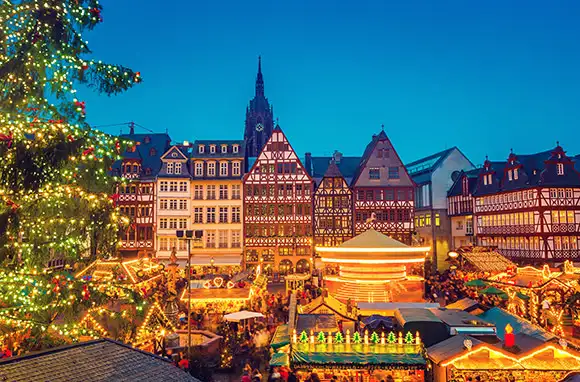
Frankfurt
Men in business suits having a lunch of bratwurst and gluhwein mingled with a surprising number of folks out shopping on a weekday afternoon. The bustling crowd didn't feel overwhelming for the modestly sized market. Though it's one of the country's oldest markets—dating back to the late 1300s—the city was substantially bombed in World War II. The market is set up in its Altstadt or Old Town—the one area of the city that doesn't have a backdrop entirely of modern skyscrapers.
Best for: Completing holiday shopping. Its close proximity to Ziel, a highly commercialized, made-for-shopping area means if you can't find all you gifts at the market, you'll find them nearby.
Must-buy: Bethmannchen. This cookie, with marzipan and almonds, is a city special.
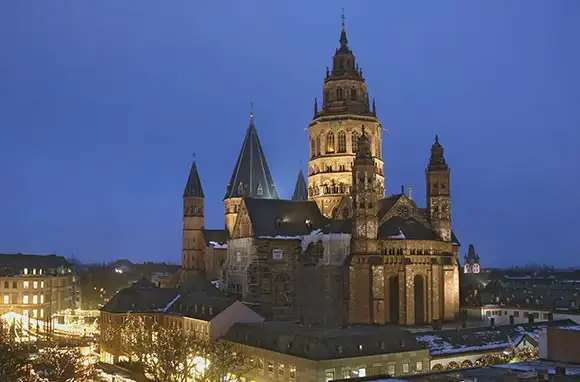
Mainz
With more of a college-town vibe than its neighbor Wiesbaden, Mainz generally takes a more "party" attitude when it comes to events. On a Tuesday night, the market was fairly reserved, with a mixed crowd that skewed young. The market ends right at the Gutenberg Museum, offering up the perfect excuse for a sausage both before and after a visit.
Best for: Socializing. If you can make plans in advance, reserve a wine barrel. Just over a dozen partially heated barrels (cozily seating about six people) surround a communal bonfire, making it possibly the warmest place out of any market to enjoy food, drink, and conversation with friends.
Must-buy: Kartoffelpuffer. Not unique to Mainz, but the potato pancakes here were some of the best, with one booth offering several topping options besides the traditional applesauce.
RELATED: What It's Really Like to Visit a Bioluminescent Bay
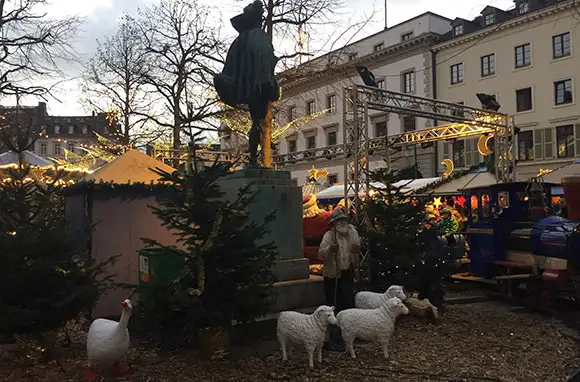
Wiesbaden
True to its reputation as a former spa town with places to "see and be seen," Wiesbaden's Christmas Market feels a bit more upscale. Several booths are small mobile shops you can enter and walk around. I visited prior to the opening celebrations that evening. Thick, wet snow—the kind you can catch on your tongue—started to fall as soon as the sun set, as if on cue for the opening celebrations.
Best for: Performances and activities. Every market has its own list of events, but Wiesbaden seems to always have something going on, including baking classes for children, daily organ concerts, dance groups, magicians, and even meditation.
Must-buy: Dornfelder gluhwein. The German grape varietal makes mulled wine even more outstanding.
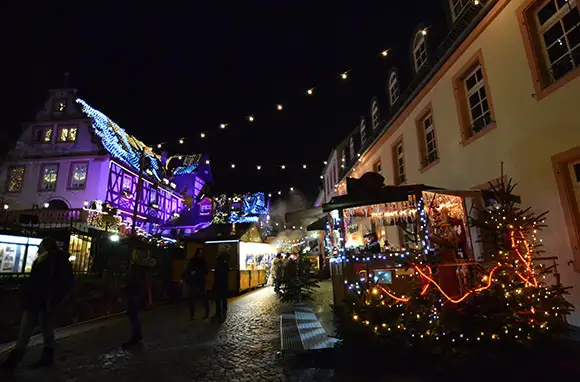
Rudesheim Am Rhein
Opening night in Rudesheim proved that weekdays are the time to go to markets. The otherwise super crowded (and touristy) town had a manageable crowd of locals out to see a singer from the area performing (mostly) English-language holiday songs. Away from the center square, speakers provided festive music. Booths throughout the market represented areas around the world. One featured Polish flatbreads, another was a replica of London's famed red double-decker buses.
Best for: Local shopping. The shops that line the town's cobblestoned streets stayed open—rare in a place when most things are shuttered no later than 5:00.
Must-buy: Rudesheim Coffee. Made with locally distilled Asbach Uralt brandy, two sugar cubes lit on fire for a subtle smoky flavor, coffee, whipped cream, and chocolate shavings on top, this is a decadent drink best reserved for daytime hours. Also available in a passion fruit version.
RELATED: What It's Really Like to Sleep in a Treehouse Hotel
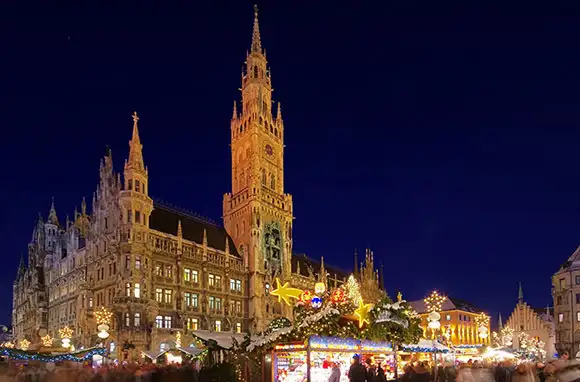
Munchen
Though Munchen (my German teacher told me never to call it "Munich" again) is better known for another festival a few months prior, the city still draws crowds for its holiday markets. Every night people gather for the live choral group perched on the Rathaus or Town Hall balcony, making the Christmas Market on the Marionplatz—the city's oldest—also one of the most crowded. The market within the Kaiserhof of the Residenz, a former royal palace in the city center, is a slightly more manageable, while the Festive Middle Age market brings a medieval feel with many merchants dressing the part.
I visited Viktualienmarkt on a Saturday morning and avoided the heavier Christmas market crowds. This year-round market still had a festive atmosphere (aided by snow that day); you could easily confuse it with one of the seasonal Christmas markets.
Best for: Big-city variety. The city has innumerable other markets across its streets (and even one at the airport).
Must buy: Nativity. The Kripperlmarkt has all the makings for a manger.
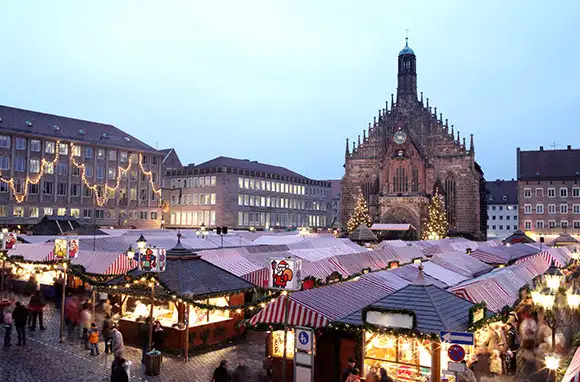
Nurnberg
Perhaps Germany's most highly touted town for Christmas festivities, Nurnberg delivers with its sheer size. But when I mentioned to a German that I would be passing through the markets, he scoffed, "It's like Oktoberfest—you have to see it once and then go to better ones."
The sheer number of stalls make this a destination you can spend a full day exploring—alongside hordes of tourists. You'll hear a lot of English spoken here. The Market of Sister Cities section features booths representing various countries. The Scotland booth, for example, was selling hot toddys made with a healthy pour of Lephroaig whiskey, while the Israel booth had a number of items for sale, including tahini.
Best for: Kids. The Kinderweihnactmarkt—in its own separate area—is any kid's dream with a miniature Ferris Wheel, small train, and a merry-go-round. While most markets cater to the kid in all of us, Nuremberg caters to the actual toddler set.
Must-buy: Nurnberger Rostbratwurste. Tiny (delicious) sausages—multiple included in an order—served with sauerkraut. Also try the Nurnberg Lebkuchen—the city's particular brand of high-quality gingerbread.
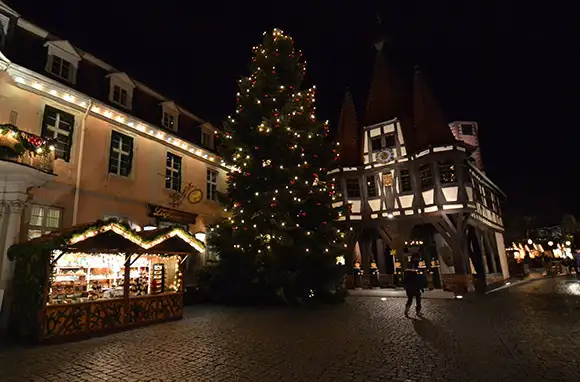
Michelstadt
This was hands-down the best and possibly least touristy Christmas Market I visited—at the advice of a German. And it confirmed that the best way to find under-the-radar market locations, as with anything in travel, is to drive outside well-known areas (and ask the locals).
Unlike other markets that are open every day, Michelstadt is open Wednesday through Sunday. But it's worth waiting until midweek to visit. The city's half-timbered houses and maze of cobblestoned alleys make an idyllic backdrop for the holidays. Booths wind their way throughout the town, providing ample space for traffic flow. A slew of larger-than-life wooden figurines, some mechanical, depict various holiday scenes.
Best for: An authentic Christmas market experience.
Must-buy: Anything from the area craftspeople. Woodworkers, glassblowers, bakers, and more set up demonstration workshops.
More from SmarterTravel:
- Europe's Most Secret Villages
- 10 Secret Perks of Europe in the Low Season
- 10 Best European Castles You Can Visit
Kate Sitarz also writes for Zipcar while eating, drinking, and hiking her way through the world. Follow her nomadic life on Instagram @katesitarz and Twitter @katesitarz<
We hand-pick everything we recommend and select items through testing and reviews. Some products are sent to us free of charge with no incentive to offer a favorable review. We offer our unbiased opinions and do not accept compensation to review products. All items are in stock and prices are accurate at the time of publication. If you buy something through our links, we may earn a commission.
Top Fares From Columbus, OH
Today's Top Travel Deals
Brought to you by ShermansTravel
Shop and Save with Country Inns...
Patricia Magaña
 Hotel & Lodging Deals
Hotel & Lodging Deals
$229 -- Chicago: Discounted Rates and...
Francesca Miele
 Hotel & Lodging Deals
$229+
Hotel & Lodging Deals
$229+
$188 -- Honolulu: Save on Oceanview...
Abigail Lamay
 Hotel & Lodging Deals
$188+
Hotel & Lodging Deals
$188+



